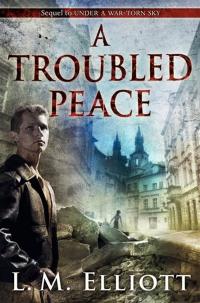About the Book
A Troubled Peace, the sequel to L. M. Elliott’s award-winning Under a War-Torn Sky, chronicles nineteen-year-old U.S. Air Force pilot Henry Forester’s adventures in France from March through July 1945. Although Henry safely returned from World War II to his family’s tidewater Virginia farm the previous year, he is scarred emotionally by the horrors of war, and he suffers from nightmares and flashbacks. Leaving his parents, dog, and girlfriend, Patsy, Henry sneaks back into France in an attempt to find Pierre Dubois, the young boy who once saved his life, and thus fulfill his promise, find salvation, and move on with life.
About the Author
L.M. Elliott wrote for the Washingtonian magazine, in the nation’s capital, for two decades before devoting her time to fiction for young adults and children. Under a War-torn Sky is a NCSS/CBC Notable Children’s Social Studies book, a Jefferson Cup Honor Book, and winner of the 2001 Borders’ Original Voices Award for Young Adult Literature. Her Civil War novel, Annie, Between the States, is an IRA Teachers’ Choice, a New York Public Library Book for the Teen Age, and a finalist in the Virginia Readers Choice 2006-2007. Flying South, set in 1968, won the Joan G. Sugarman Award for Children’s Literature.
To learn more about the author, watch our video interview with L.M. Elliott.
Discussion Questions
- Do you think Henry’s plan to illegally sneak back into war-torn France is wise? Is he well prepared? Why does Henry’s mother encourage him to go?
- What is rationing? What items in the United States and France were rationed during World War II and why? What is the black market? Why do the police think Henry is a black marketer? What are bribes?
- In chapter six, the restaurant owner in Marseille says, “The world is full of grays, in-betweens. Especially France right now.” What does he mean? Who or what are the RMAs, turncoats, collaborators, maquis, Vichy government, Free France, Milice, Gestapo, and Allies? Were all Germans bad and all Allies good? Are people and issues ever only bad or good, or do all things have gray areas?
- Who are the Absents? What does the sky represent to the woman exiting Gare de l’Est in chapter twenty-one?
- In chapter twenty, Orwell says, “Peace? Peace is not that easy, that finite, my boy. War ends; then it takes a long time to negotiate a real truce.” What do you think Orwell means? What problems come with peace? How is the United States now experiencing the difficulties of negotiating peace and assessing the price of war?
- What examples of hatred and revenge can you find in A Troubled Peace? Have you experienced these emotions? Who do they hurt more, you or the object of your feelings?
Extension Activities
- Research the historical figure of Madame Zlatin. What did she do during the war? What causes Henry to ponder in chapter twenty-five, “But fate wasn’t fair-minded, was it?” What happened at Hotel Lutetia? Is life fair? Should it be?
- On a map of France, find the cities and rivers mentioned in A Troubled Peace and follow Henry’s quest for Pierre Dubois. Include the following: Annecy, Chabeuil, Grenoble, Lyon, Marseille, the Massif Central, Montélimar, Morvan, Normandy, Paris, the Pyrenees, the Rhône River, the Seine River, Valence, Vassieux, and Vercors. Famous Parisian buildings and monuments are also mentioned. Locate them on a map of Paris and look at photos of these magnificent structures. Which ones would you most like to see?
- Albert Camus, Simone de Beauvoir, Antoine de Saint Exupéry, Ernest Hemingway, George Orwell, and Jean-Paul Sartre are all famous authors mentioned in A Troubled Peace. Choose one of these authors and research his or her life during World War II. Then read one of this author’s works and think about how it relates to L. M. Elliott’s novel.
- Learn to recognize the various Allied and German airplanes used during World War II. Airplane spotters could recognize them by their silhouettes — can you? Messerschmitts, B17s, B24s, and Spitfires are mentioned in A Troubled Peace. What other planes were flown and what were the uses for each?

A Troubled Peace
